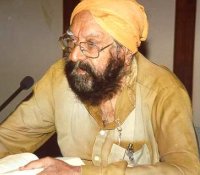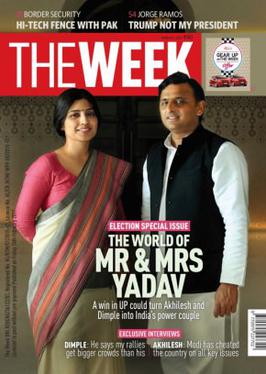
The Times of India, also known by its abbreviation TOI, is an Indian English-language daily newspaper and digital news media owned and managed by The Times Group. It is the third-largest newspaper in India by circulation and largest selling English-language daily in the world. It is the oldest English-language newspaper in India, and the second-oldest Indian newspaper still in circulation, with its first edition published in 1838. It is nicknamed as "The Old Lady of Bori Bunder", and is an Indian "newspaper of record".

Bennett, Coleman and Company Limited,, is an Indian media conglomerate headquartered in Mumbai, Maharashtra. The company remains a family-owned business with Sahu Jain family owning a majority stake in The Times Group.

Khushwant Singh was an Indian author, lawyer, diplomat, journalist and politician. His experience in the 1947 Partition of India inspired him to write Train to Pakistan in 1956, which became his most well-known novel.

Filmfare is an Indian English-language fortnightly magazine published by Worldwide Media. Acknowledged as one of Indias most popular entertainment magazines, it publishes pieces involving news, interviews, photos, videos, reviews, events, and style. The magazine also annually gives the Filmfare Awards, the Filmfare Awards South, the Filmfare Awards East, the Filmfare Marathi Awards, the Filmfare Awards Punjabi, the Filmfare OTT Awards, the Filmfare Short Film Awards, and the Filmfare Style & Glamour Awards.

Hindustan Times is an Indian English-language daily newspaper based in Delhi. It is the flagship publication of HT Media, an entity controlled by the K. K. Birla family, and is owned by Shobhana Bhartia.

The Tribune is an Indian English-language daily newspaper published from Amritsar, Jalandhar, Ludhiana, Bathinda, Chandigarh and New Delhi. It was founded on 2 February 1881, in Lahore, Punjab, by Sardar Dyal Singh Majithia, a philanthropist, and is run by a trust comprising five persons as trustees. It is a major Indian newspaper with a worldwide circulation. In India, it is among the leading English daily for Punjab, Haryana, Himachal Pradesh, and the Union Territory of Chandigarh.
Girilal Jain, was an Indian journalist. He served as the editor of The Times of India from 1978 until 1988. He advocated establishing old glory and re establishing the great tenants of Hinduism aligned with nationalism and authored books on the subject, the best known of which, The Hindu Phenomenon, was published posthumously. The government of India awarded him the civilian honour of the Padma Bhushan in 1989.
"With Malice towards One and All" was the weekly column series published by Indian author and journalist Khushwant Singh in the leading English language dailes of India, occupying two full length columns on the editorial page of the Saturday edition.

Pritish Nandy is an Indian poet, painter, journalist, parliamentarian, media and television personality, animal activist and maker of films, TV and streaming content. He was a parliamentarian in the Rajya Sabha from Maharashtra, elected on a ticket from the Shiv Sena. He is the author of forty books of poetry in English and has translated poems by other writers from Bengali, Urdu and Punjabi into English as well as a new version of the Isha Upanishad. Apart from these, he has authored books of stories and non fiction as well as three books of translations of classical love poetry from Sanskrit. He was Publishing Director of The Times of India Group and Editor of The Illustrated Weekly of India, The Independent, and Filmfare in the 1980s, all simultaneously. He has held six exhibitions of his paintings and calligraphy. He founded Pritish Nandy Communications Ltd, the content company, in 1993. He also founded People for Animals, India's first animal rights NGO which is currently run by co-founder Maneka Gandhi as chairperson.
Sardarji jokes or Sardar jokes are a class of ethnic jokes based on stereotypes of Sikhs. Although jokes about other ethnic and linguistic communities are found in various regions of India, Sardarji jokes are the most widely circulated ethnic jokes and found across the country. Sardarji jokes are generally considered tasteless and inappropriate by members of the Sikh community, and have elicited protests as well as leading to arrests for hurting religious sentiments.

The Week is an Indian news magazine founded in the year 1982 and published by The Malayala Manorama Co. Pvt. Ltd. The magazine is published from Kochi and is currently printed in Delhi, Mumbai, Bengaluru and Kottayam. According to the Audit Bureau of Circulations, it is the largest circulated English news magazine in India.

Navtej Singh Sarna is an Indian author-columnist, diplomat and former Indian Ambassador to the United States. He previously served as the High Commissioner of India to the United Kingdom, and the Ambassador to Israel.
Samir Jain is an Indian publisher and the Vice-Chairman and Managing Director (VCMD) of Bennett, Coleman & Co. Ltd., also known as The Times Group, a leading media conglomerate with its primary base of operations in India, which publishes The Times of India and has many other interests. Jain belongs to the Sahu Jain family, an industrialist family of India.
Mathrubhumi Azhchappathippu is an Indian general interest weekly magazine published by the Mathrubhumi Printing and Publishing Company in Calicut. The Malayalam language magazine started publishing on 18 January 1932.
Encyclopedia of Hinduism, 1st ed., 2012, is a comprehensive, multi-volume, English language encyclopedia of Hinduism, comprising Sanātana Dharma, a Sanskrit phrase, meaning "the eternal law", or the "eternal way", that is used to refer to Hinduism, Buddhism, Jainism and Sikhism. It is a 7,184 page, 11-volume publication with full-color illustrations of temples, places, thinkers, rituals and festivals. Encyclopedia of Hinduism is an inspiration and dream project of Swami Chidanand Saraswati, President of Parmarth Niketan and India Heritage Research Foundation. Under preparation for 25 years, it has been edited by Dr. Kapil Kapoor with contribution from over 2000 scholars.
In India, paid news is the practice of cash payment or equivalent to journalists and media organizations by individuals and organizations so as to appear in their news articles and to "ensure sustained positive coverage". This practice started in the 1950s and has become a widespread organized activity in India through formal contracts and "private treaties". Pioneered by Bennett, Coleman & Company, Ltd. (B.C.C.L.) group through their Times of India publication and widely adopted by groups such as The Hindustan Times, Outlook and others, the practice was brought to Western media attention in 2010. Paid news financially benefits the "individual journalists and specific media organizations" such as newspapers, magazines and television channels according to a 2010 investigative report of the Press Council of India. It is paid for by politicians, organizations, brands, movies and celebrities who seek to improve their public image, increase favorable coverage and suppress unfavorable information.
Avadhanam Sita Raman was an Indian writer and journalist and a former editor of the Illustrated Weekly of India. Born on 9 April 1919 at Proddatur in Kadapa district in the South Indian state of Andhra Pradesh, he secured his master's degree in economics from the Andhra University College of Arts and Commerce, Waltair. He started his career in 1936 as a writer and journalist with freelance contributions to English and Telugu publications such as Triveni, a literary and cultural quarterly. Later, in 1943, he joined the Hindustan Times in the capacity of a sub editor, moved on to publications such as The Statesman and The Times of India before joining the Illustrated Weekly of India in 1953, and rose to the rank of the Editor, the first Indian editor of the weekly. He also worked as an art consultant to The Studio (magazine), London. At the end of the seventies, he joined Swarajya, a Chennai-based weekly magazine.
Roshmila Bhattacharya is an Indian journalist, author and editor, who has worked for The Times Group's publication Mumbai Mirror since 2013. Starting her career in the 1980s, she also worked for newspapers Hindustan Times, The Asian Age, The Times of India and The Indian Express and several magazines, including Filmfare, Screen and The Illustrated Weekly of India. She has written two books: Bad Man and Matinee Men: A Journey Through Bollywood.









